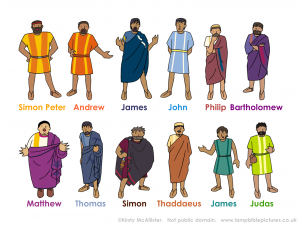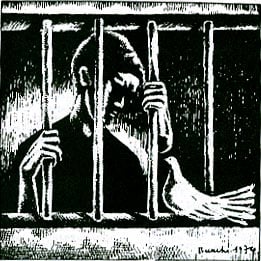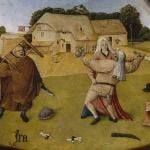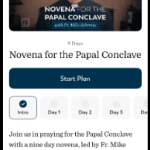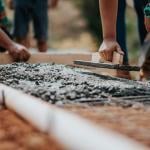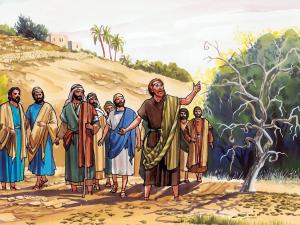
A fig tree helps us interpret one of the surest, but not always understood, facts about Jesus’ life. Jesus committed an act of civil disobedience in the Temple. We usually call it a “cleansing” but, as Mark tells it, it’s more likely a symbolic destruction. What happens to a fig tree indicates what Jesus thinks needs to happen to the oppressive system that the temple embodies.
Eighteenth in a series on “The Worldly Spirituality of Mark’s Gospel”with help from Ched Myers’ Binding the Strongman: A Political Reading of Mark’s Story of Jesus. The Introduction and a Table of Contents are HERE.
After Palm Sunday’s street theater, Jesus spends Sunday night in Bethany. Monday Jesus stages another demonstration, whose meaning escapes many commentators. Even the choice of a heading in my Bible, “Cleansing of the Temple,” misses the point. Jesus, in Mark at least, is not cleansing the temple but symbolically destroying it.
A demonstration planned in advance
The picture of this incident that I held at one time, I think, is a common one. Jesus enters the temple and sees how poor people are being swindled by money changers and by sellers of animals for sacrifice. He gets worked up into a rage and starts beating up (more or less) people and animals for turning God’s house of quiet prayer into raucous “den of thieves.” (Mark 11:17)
That scenario seems unlikely for a few reasons. First, Jesus surely knew all along what went on in the temple during major feasts. He’d been there many times before. So he couldn’t have been taken by surprise on that Monday morning. He knew what he was going to do. Second, it no doubt was raucous in that outer court of the temple, but the selling of animals and money changing were an ordonary part of preparation for worship in the temple. There’s no indication that anybody was cheating anybody. Jesus’ words about the “den of thieves” tell a different story. After all, thieves don’t do their stealing in their own den. The den is where they hide out after doing their evil work somewhere else.
Fianlly, in Mark’s story there’s a curious incident with a fig tree, the telling of which both precedes and follows the temple demonstration. This split episode, another example of Mark’s sandwiching technique, helps us interpret Jesus’ behavior in the temple. Jesus is not just cleaning. Let’s look at the story and symbolism of the fig tree.
Fig tree symbolics
Jesus, on his way from his friends’ place in Bethany back to Jerusalem, is hungry. (A Markan touch, or did Jesus forget breakfast that morning?) He sees a fig tree in the distance, but approaching he finds no figs. It wasn’t the time for figs. (Didn’t Jesus know that without having to get a closer look?) Jesus curses the fig tree, “May no one ever eat of your fruit again!” (Mark 11:14)
I have to believe Mark made this story up to symbolize something. Myers says trees in the Old Testament are practically always symbolic. (Myers, p. 297) The fig tree often symbolizes Israel. Flourishing, it means blessing on the nation. When it withers, it foretells judgment. In this case, Mark is showing us Jesus’ judgment on the temple because it provides religious cover for a financial systems that favors the rich, including the high priestly families, and dispossesses the poor.
When Mark’s readers come to Tuesday morning and the second slice of bread sandwiching the action in the temple, they will see the fig tree has withered. They will easily apply the tree’s fate to what Jesus intends for the temple.
Direct action in the temple
But now it’s still Monday morning and Jesus is in the temple. With three separate actions he makes three decisive attacks against the sacrificial system that the temple represents. Jesus
- drives out “those who were selling and those who were buying in the temple.”
- overturns “the tables of the money changers and the seats of those who sold doves.”
- “would not allow anyone to carry anything [any ‘goods’] through the temple.” Mark 11:15-16)
The first action targets the temple as a marketplace. The second brings crashing down two essentials of the sacrificial system—changing foreign money into temple money and selling doves.
The action against the dove sellers is especially telling. Doves were the sacrificial animal that the poor could afford and also the proper sacrifice for purifying women. (Myers, p. 201) Jesus has already shown particular interest in both those groups. Here he shows what he thinks about their having to pay anything for God’s favor.
The third action is the most radical of the three. “Goods” are any of the items necessary for the temple cult, and Jesus interrupts their flow. Mark’s readers will remember that Jesus threatened to plunder the devil’s “goods.” I wrote about this before. Some scribes had accused Jesus of casting out devils by Beelzebul. Jesus subtly turned the accusation against them and made a not very well-disguised threat about plundering their (meaning the devil’s) “goods.” (Mark 3:20-27) The same word is used in that incident and here.
A diabolical kingdom and house
It’s worth quoting Jesus’ words on that earlier occasion. Notice how many times he repeats himself—unnecessarily if all he is saying is that he is not working with the devil:
How can Satan drive out Satan? If a kingdom is divided against itself, that kingdom cannot stand. And if a house is divided against itself, that house will not be able to stand. And if Satan has risen up against himself and is divided, he cannot stand; that is the end of him. (Emphasis mine)
The key words “kingdom” and “house” represent the scribes’ concerns. They are the supposed heirs of the Davidic kingdom and custodians of the house of God, the temple. But when Jesus applies these words to the devil, he makes a subtle reference to the scribes’ own identity. He puts the scribes in the same class as the devil. Then comes the threat, which Jesus will fulfill symbolically by his action in the temple:
But no one can enter a strong man’s house to plunder his property [“goods”] unless he first ties up the strong man. (Mark 3:25-27)
Our translations obscure an important point. “Property” in Jesus’ threat is the same word as “goods” in the temple action. Jesus equates these temple accessories with the devil’s goods. Jesus, the one whom the Baptist called the “stronger one” (Mark 1:7) is making good on his earlier threat by his action in the temple. Jesus’ goal is “a shutting down of temple operations altogether.” (Myers, p. 301)
Jesus appeals to Scripture
Finally, Jesus teaches:
Is it not written, “My house shall be called a house of prayer for all the nations?” [quoting what scholars call Third Isaiah] But you have made it a den of robbers [quoting Jeremiah].” (Mark 11:17)
In Third Isaiah (56:3-8) the Old Testament finds its fullest statement of inclusiveness, of gathering in the foreigner and the despised. In Jeremiah (7:3-15) God intends to destroy the temple in Jerusalem because of failure to deal justly with the neighbor, failure to refrain from oppressing the alien, the orphan, and the widow, failure to stop going after false gods.
These condemned practices against the ones Jesus favored most, the poor and marginalized, were standard in the temple-driven economy of Jesus’ time. Jesus knows his Scriptures. He has concluded that the system needs more than reform if it is to be true to its Jewish identity.







